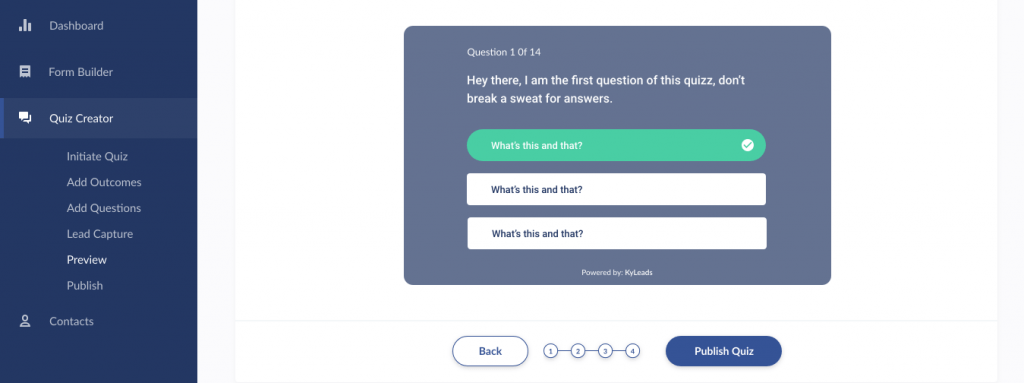You’re surfing Facebook and run across a quiz about sculpting your abs.
You click through and it has a nice title and the description makes you want to dive right in – so you do. Something is off. The quiz questions seem irrelevant.
You answer a few but feel like you’re being shortchanged so you click the back button and write the website off. An otherwise great experience is marred by poor presentation.
The potential of interactive quizzes to get you 2-10x more leads is too good to pass up. With the right topic and audience, the quiz practically does the work itself. Well, that’s the theory.
In reality, you need to ask the right questions to get the results you want and give your audience the result they want.
There’s a simple process to follow that’ll make all the difference when it comes to crafting the right quiz questions. Let’s dive in.
Table of Contents
Quiz questions come last, the outcomes come first
After you’ve gotten the best title, the next step isn’t to write quiz questions. First, you need to decide what the outcomes for your quiz takers are.
Before you leave the airport you need to know where you’re going right?
This is the same principle.
When you create the outcomes first, you set up guideposts for your quiz questions. It prevents you from going too wide with your questions and having to rewrite them later. At the same time, the outcomes are what your audience is waiting for. It’s the intrinsic part of motivation.
Here are some things to keep in mind when writing your outcomes:
They should be crafted for a specific segment of your audience
If you’re Buzzfeed or a general media company that doesn’t care too much for targeted leads then you can make the outcomes generic.
If, on the other hand, you’re looking for qualified leads then your outcomes should speak to them. If not, they’ll feel shortchanged and write you off without a second thought.
That’s not the goal here.
Instead of that route, drill down. Don’t be afraid to expose the real pains and challenges someone who gets a specific result would experience.
For example, if your quiz is focused on the fitness level of the quiz taker, you’d have multiple outcomes like beginner, intermediate, and advanced.
Your outcome for beginner could let them know they’re a beginner, touch on specific problems beginners tend to experience, and the next steps to take.
If you have a quiz about a little black dress, your outcomes could focus on different styles. Touch on why that dress’ style fits their personality (and even the story of the dress), a few ways to wear the dress, and events where it’s ideal.
When you wear the dress that perfectly matches your personality and body type, a whole world of styling possibilities opens up. A timeless LBD isn’t just a piece of clothing – it’s your secret weapon for those last-minute dinner plans or impromptu office-to-cocktails transitions.
Take Sarah’s story – she found her perfect fit at a vintage boutique and now rocks it for everything from client meetings to gallery openings, just switching up accessories to create completely different vibes.
Interactive content is the hot new thing for businesses looking to truly connect with their audience and drive those all-important conversions. But creating experiences that are genuinely engaging? That’s an art form. You’ve got to deeply understand what makes your users tick and channel your inner storytelling genius.
A killer interactive experience should feel like it’s seamlessly blending the educational (or promotional) elements with pure entertainment – taking people on a journey that’s tailored to their unique personalities and needs.
Note: Longer ecommerce descriptions and storytelling have been known to sell more products. Check out this website, for a first hand look at how stories make your offers more valuable.
Aim for a few paragraphs as opposed to a few sentences.
Remember, these are people who went through your entire quiz, parted with their email address, and want to know more about themselves and the problem you’re addressing. A few paragraphs won’t scare them away.
Use images in the outcomes
Images consistently outperform text on almost every platform. They perform better on Twitter, they perform better on Facebook, and they perform better with blogging.
The same holds true with your quiz outcomes. Incorporate a relevant image to illustrate the outcome. You get bonus points if you use custom illustrations or images.
A personality quiz is evergreen. If you use a product recommendation quiz then it’ll last at least as long as the season.
Moving on.
In the end, spending more time on your quiz outcome makes it more likely your quiz taker will share it with their followers on social media. It also increases engagement on the follow-up emails you send.
Crafting quiz questions that work
After you’ve made a few outcomes you can put together questions that’ll get you the results you want. There are no hard and fast rules for making quiz questions. There are a few guidelines that when followed will help you make compelling quiz questions.
Keep your target audience in mind for quiz questions
You made outcomes for specific segments of your target audience. The questions follow suit. If you did the research needed to make the right outcomes in the first part then this part is easy. After all, 71% of people feel personalization would impact their decision to interact with brands.
The beauty of quiz questions is that you can be less formal than in other correspondence. It’s meant to be a fun experience that creates intrinsic motivation for participants. Even if you tend to be more formal, you can use quizzes to loosen up a bit.
Structure the questions to use terms your target audience would use in normal conversation when describing the problem you’re addressing. The proper term may be xd341 glass but your audience knows it as iPhone glass. Use iPhone glass in your question.
If they call carbonated water with food coloring coke, guess what? You call it coke.
Go from easy to hard
The fastest way to scare people away from your quiz is to start with questions that’re too hard or involved. Ease into the process.
Think of it like courtship. You don’t come out and tell someone you’d screw their brains out (if you do let me know how that works for you in the comments), you ease into it. You start with a coffee date, send messages, long calls, dinner, and then you ask them to go steady.
There’s no difference between that and your quiz questions. Well, the only difference is that the quiz only takes two to three minutes.
Avoid being clever with your questions or trying to trick people. You want clean data that’s representative of your new subscriber. If they don’t understand the question then they won’t enjoy the experience or give you the best answer.
That doesn’t mean the questions should be boring. Start with an exciting question and end with an exciting question.
Allow your brand to shine
You want your quiz to be a positive touchpoint between you and your audience.
Do use language your audience uses and understands.
Don’t incorporate current pop culture references.
You don’t want to limit the shelf life of your quiz because you tied it to the world cup. The people who opt in because you mentioned Ronaldo will unsubscribe quickly. A better option is to incorporate themes at the core of your brand.
For a fashion brand that may be luxury and sophistication.

Or maybe your brand centers on being sustainable. Incorporate those elements into your quiz.
If creating lasting success is one of the pillars of your brand then make that a part of your quiz.
Your brand is unique and by associating with you, your audience uses you as a reflection of their self-identity. Reinforce the qualities that brought them to you in the first place and avoid the lure of quick spikes in traffic.
Number of questions (7-10)
There’s no perfect answer to this question. Some places say seven, some say eight, some say as many as twelve. We have our own data which we’ll publish in due time.
Until then, stick with between 7-10 questions. This is long enough to feel like you’ve asked questions that reveal true insights and short enough to prevent fatigue. Even though it’s interactive content, that doesn’t mean people won’t get tired if it goes on too long.
Life is a distracting taskmaster.
Remember, this is a rule of thumb so I encourage you to test it yourself.
Last but not least, here’s a resource that’ll help you jog your creative muscles to create compelling quiz questions: Conversation Starters World
Conclusion
Interactive quizzes can do everything you need them to do. That will only happen if you ask the right questions.
It’s important to find a balance between what you need to grow your business and what your audience wants. If you fail in either regard then the quiz won’t perform as well as you hope.
Each quiz question, when done right, will move your prospect closer to where you need them to be in order to make a buying decision. Keep the following points in mind:
- The outcomes come first
- Write questions that appeal to a specific segment of your audience
- Go from easy to hard
- Don’t try to be clever
- Show your brands personality
- Keep your quizzes below ten questions
Let us know if you have any questions or thoughts in the comments. Don’t forget to share.


